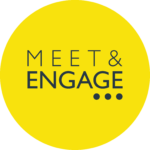Content provided by: Meet & Engage
Meet & Engage offers four tips to make sure your virtual hiring events cut through the noise and stand out from the crowd.
This article is taken from the latest Meet & Engage whitepaper. You can read the whitepaper in full, here.
In the past year, employers have been forced to rethink their talent attraction strategies. From physical campus fairs to in-person interviews and assessment days, the entire candidate experience has been flipped on its head.
In a recent survey, we asked 50+ talent professionals what their candidate events strategy looks like in 2021. Get this: 83% said their recruiting strategy would consist of entirely virtual events in 2021.
Clearly, employers are seeing online events as a solution to challenges posed by lockdowns, remote working and social distancing.
And it’s not just a temporary fad, either. New research from LinkedIn shows that 81% of talent leaders say virtual recruiting will continue post-COVID, while a further 70% say it will become the new standard in talent acquisition.
But as online events grow in popularity and prominence, so too does competition for candidate attention. It’s within this new landscape that employers will need to work smarter if they wish to successfully convert interest into engagement and action.
If virtual events are on your radar or part of your strategy in 2021, then here are four powerful ways to make sure your events cut through the noise and stand out from the crowd.
1. Know your audience
When it comes to running virtual hiring events, too many employers run cookie-cutter events where a hiring manager speaks at a candidate for 30 minutes about why their company is such a great place to work.
To make your event stand out, you need to deliver content that will truly resonate with your audience. Start by identifying the key persona groups you’re trying to hire – that could be recent graduates, women in tech or experienced hires.
Next, understand the motivators that will excite, engage and inspire your audience. This could include practical considerations like ‘how the interview process works’ or more emotional drivers such as ‘what it feels like to overcome challenges and thrive at your organisation’.
By creating a full persona profile of your audience, you can better plan the type of content you need to present during the event. You’ll also have a much firmer understanding of the types of messages you should be promoting to your audience pre-event (think custom marketing campaigns targeting people on their most-used social channels).
2. Find a flexible and reliable technology partner
This might seem like a given, but you’d be surprised to learn how many organisations struggle when it comes to selecting the right virtual events technology. Platforms like Zoom and Teams might work great for internal meetings, but running live events for a wide range of candidate audiences is an entirely different ball game.
Many platforms have limitations on what they can and can’t do, which may impact your ability to bring your employer brand to life and truly connect with people on a one-to-one basis.
To make your virtual events stand out, you’ll want to ensure your technology allows you to:
- Customise your event platform and fully-brand this with your unique employer brand
- Apply media tracking and tagging codes
- Run group and 1-2-1 chats
- Live streaming functionality and support
- Shareable polls with instant feedback and share options
- Let candidates ask questions in a moderated setting
- Track data and analyse candidate feedback – during and post-event
- Automated Net Promoter Score (NPS) email to candidates
This list is by no means exhaustive, but it should give you a sense for the types of functionality you’ll want to look out for.
3. Turn your employees into brand advocates
To make your virtual events stand out, there’s nothing more powerful than leveraging your existing talent to tell the story of your brand.
Remember, live events are a great way to showcase your organisation’s strengths and reveal the ins and outs of what it’s truly like to work there. We’re talking about the things you can’t find on a static web page or in an employer brand video.
If you’re looking to attract a diverse or niche audience group, for example, studies show that connecting those people with similar personalities and demographics within an organisation goes a long way towards building trust and belonging.
Diageo, for example, noticed that there were several key points in the recruitment journey where candidates stalled and needed support. They found a high number of female candidates weren’t completing the video interview stage. To support candidates, Diageo launched a series of live events hosted by real employees who had joined the graduate programme the previous year. These women spoke about their own personal experiences within the organisation – the highs, the lows and everything in between.
This highly authentic and genuine conversation led to a marked uptick in candidates’ confidence and trust levels. In fact, by the end of the sessions, 80% of the female candidates who had asked questions about the video interview stage went on to complete this step.
Simply put, if you want to make your events stand out over and above the competition, you need to bring your own employees’ experiences to life. This shifts the focus away from a “recruiter speaking at a candidate” to “someone that looks and sounds like me sharing their own personal experience”.
At a time when candidates trust a company’s employees 3x more than the company to provide credible information on what it’s like to work there, this can make all the difference.
4. Don’t be afraid to push the boundaries
The act of hosting a virtual event alone won’t make you stand out, but your speakers, theme and content will provide candidates with real value.
Don’t let your virtual recruiting events fall into a generic template and structure…
“This is what we do, here’s how we do it and this is what we have to offer. Any questions?”
There’s nothing wrong with this approach per se, but it certainly won’t make your online event stand out. If you’re looking for an example of a top-notch virtual event series, then look no further than Accenture Live.
In 2020, the team at Accenture did a fantastic job of pivoting to a virtual events strategy, creating and broadcasting more than 20 live candidate events over the course of the year. These events spanned technology showcases, practical workshops, panel discussions with guest speakers and diversity and inclusion sessions with current employees from diverse backgrounds.
These live sessions pushed the boundaries of virtual candidate events and included honest conversations about the pressing issues facing the company and society at large. With the help of subject-matter experts, Accenture explored questions around LGBT+ initiatives and hosted an event that addressed questions of race and diversity (in partnership with the company’s African & Caribbean Network).
In total, Accenture ran 22 virtual events which drove 5,475 candidate sign-ups, 3.463 attendees, 2,000+ comments and 22 hours of original content. From an employer brand perspective, 85% of candidates said they were “very likely” to apply after attending the sessions.
It’s a great example of how live virtual events can help you attract talent and stand out from the crowd – but to make this happen, you need to be willing to push the boundaries and explore sensitive topics.
This article is taken from the latest Meet & Engage whitepaper. You can read the whitepaper in full, here. You can find out more about Meet & Engage at meetandengage.com



0 Comments